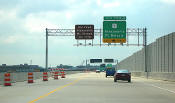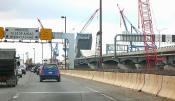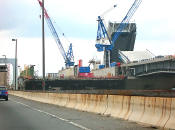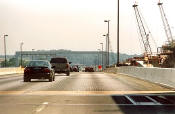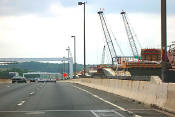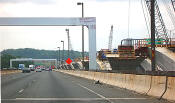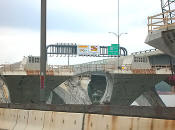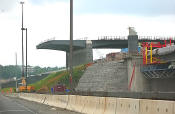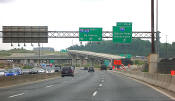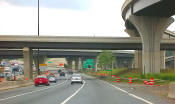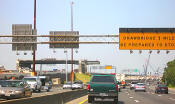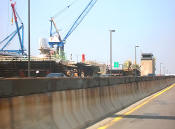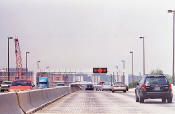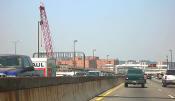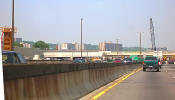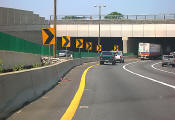| Woodrow Wilson Bridge Project Photos - May 2006 |
The following 34 photos were taken on May 18, 2006, by Roads to the Future. This was at the dedication ceremony for the first new Woodrow Wilson Bridge. This is the 6-lane bridge for the Outer Loop of the I-95/I-495 Capital Beltway, which will open to traffic in June and July of 2006, and it will be configured for 3 lanes each way until the 6-lane bridge for the Inner Loop of the Beltway opens to traffic in mid-2008. The completed twin bridges will have a total of 12 lanes on 4 separate roadways on a 3-3-3-3 lane configuration.
The large photos have sizes ranging from 149 to 257 kilobytes, with most of them being under 185 kilobytes. With a broadband or network Internet connection each photo will download within seconds, but with a dial-up Internet connection it will be somewhat slower.
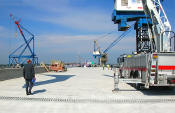 |
Woodrow
Wilson Bridge, heading westbound toward Virginia. The mid-point of the bridge
and the drawspan is in the far distance. The next 5 photos advance in sequence westbound toward Virginia. Vehicles and stages related to the ceremony are in various places on the bridge. |
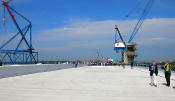 |
Woodrow Wilson Bridge, heading westbound toward Virginia. The mid-point of the bridge and the drawspan is in the distance. |
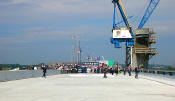 |
Woodrow Wilson Bridge, heading westbound toward Virginia. The mid-point of the bridge and the drawspan is in the distance. The under-construction new drawbridge Operator's Tower is visible to the right. |
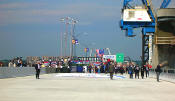 |
Woodrow Wilson Bridge, heading westbound toward Virginia. The mid-point of the bridge and the drawspan is in the foreground. The under-construction new drawbridge Operator's Tower is visible to the right. The ceremonial platforms and seating is ahead. |
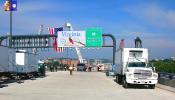 |
Woodrow Wilson Bridge, heading westbound toward Virginia. The drawspan is just behind this spot. |
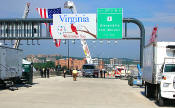 |
Woodrow Wilson Bridge, heading westbound toward Virginia. The Virginia Potomac River shoreline is almost directly under the Virginia welcome sign. |
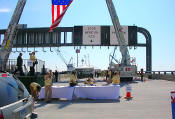 |
Woodrow
Wilson Bridge, heading eastbound toward Maryland. The mid-point of the bridge
and the drawspan is a couple hundred yards ahead.
Vehicles and stages related to the ceremony are in various places on the bridge. The next 2 photos advance in sequence eastbound toward Maryland. |
 |
Woodrow Wilson Bridge, heading eastbound toward Maryland. The mid-point of the bridge and the drawspan is in the foreground. The joint between the bridge and the drawspan is visible at the bottom of the photo. |
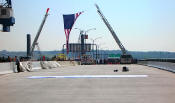 |
Woodrow Wilson Bridge, heading eastbound toward Maryland. The Maryland shore is visible in the distance. |
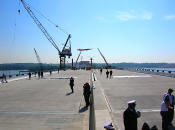 |
Woodrow Wilson Bridge, looking eastbound from a stage over the center of the bridge, toward Maryland. The Maryland shore is visible in the distance. The joint between the bridge and the drawspan is visible at the bottom of the photo. |
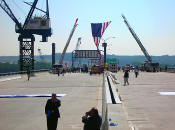 |
Woodrow Wilson Bridge, same vantage point as previous photo, with telephoto. |
 |
The first
ceremonial vehicle to cross the new bridge was
President Woodrow Wilsonís own 1923 Rolls Royce Silver Ghost (courtesy
of the Woodrow Wilson House). Woodrow Wilson's Rolls-Royce will be on display for two years. You can learn more about it and the Woodrow Wilson House by visiting www.woodrowwilsonhouse.org or by calling 202-387-4062. |
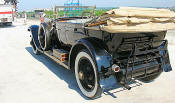 |
Woodrow Wilson's Rolls-Royce. The car is privately owned today. |
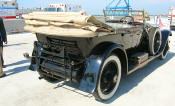 |
Woodrow Wilson's Rolls-Royce. |
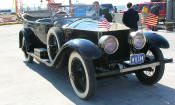 |
Woodrow Wilson's Rolls-Royce. |
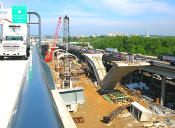 |
Virginia
approaches construction to the Potomac River Bridge for the Inner Loop bridge,
looking at the delta pier construction on the Virginia land approach, photo
taken from new WWB, and the existing WWB is in the background. The delta piers on the approach spans are being constructed via the precast segmental method, whereby reinforced concrete segments are cast in a fabrication yard, and assembled on the pier foundations and post-tensioned with steel cables that pass through channels in the piers. The arches are held in place by temporary steel cables until the reinforced concrete cross-member links the two arches. The bridge's steel beams and roadway deck are constructed across the top of the piers. |
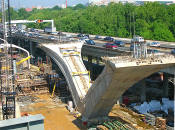 |
Virginia approaches construction to the Potomac River Bridge for the Inner Loop bridge, looking at the delta pier construction on the Virginia land approach, photo taken from new WWB, and the existing WWB is in the background. Same vantage point is previous photo, but more telephoto. |
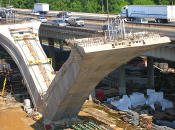 |
Virginia approaches construction to the Potomac River Bridge for the Inner Loop bridge, looking at the delta pier construction on the Virginia land approach, photo taken from new WWB, and the existing WWB is in the background. Same vantage point is previous photo, but more telephoto. |
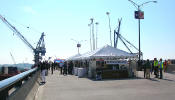 |
Woodrow
Wilson Bridge, heading eastbound toward Maryland. The mid-point of the bridge
and the drawspan is a few hundred yards ahead.
Vehicles and stages related to the ceremony are in various places on the bridge. |
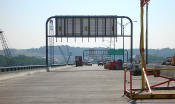 |
Woodrow Wilson Bridge, heading eastbound toward Maryland. The mid-point of the bridge and the drawspan is a couple hundred feet behind. This is the 6-lane bridge for the Outer Loop of the I-95/I-495 Capital Beltway, which will open to traffic in June and July of 2006, and it will be configured for 3 lanes each way until the 6-lane bridge for the Inner Loop of the Beltway opens to traffic in mid-2008. This roadway will have 3 lanes westbound to Virginia until the second new bridge opens, at which time this roadway will become the express lanes eastbound to Maryland. |
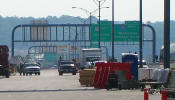 |
Woodrow Wilson Bridge, heading eastbound toward Maryland. This is a zoom-in excerpt from the previous photo (the raw images at about 1.4 megabytes each are very large and the resolution is lower on the unreduced image), to show that there is a large Maryland welcome sign on the overhead sign structure on the bridge near the Maryland end of the bridge, and while it is too far away to be clearly visible, its color scheme clearly shows it for what it is. This was the closest that I walked toward Maryland. |
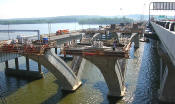 |
Maryland
approaches construction to the Potomac River Bridge for the Inner Loop bridge,
looking at the delta pier construction, photo taken from the drawspan of the
new WWB, and the existing WWB is in the background. The delta piers on the approach spans are being constructed via the precast segmental method, whereby reinforced concrete segments are cast in a fabrication yard, and assembled on the pier foundations and post-tensioned with steel cables that pass through channels in the piers. The arches are held in place by temporary steel cables until the reinforced concrete cross-member links the two arches. The bridge's steel beams and roadway deck are constructed across the top of the piers. |
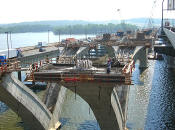 |
Maryland approaches construction to the Potomac River Bridge for the Inner Loop bridge, looking at the delta pier construction, photo taken from the drawspan of the new WWB, and the existing WWB is in the background. Same vantage point is previous photo, but more telephoto. |
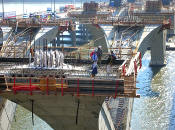 |
Maryland approaches construction to the Potomac River Bridge for the Inner Loop bridge, looking at the delta pier construction, photo taken from the drawspan of the new WWB, and the existing WWB is in the background. Same vantage point is previous photo, but more telephoto. |
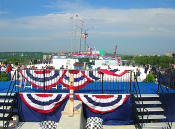 |
Woodrow Wilson Bridge, looking westbound from a stage over the center of the bridge, toward Virginia. The Virginia shore is visible in the distance. The stage for the ceremony is ahead. |
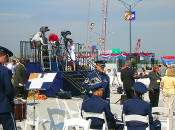 |
Woodrow Wilson Bridge, looking westbound toward Virginia. The stage for the ceremony is ahead. |
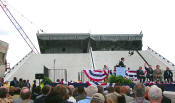 |
Woodrow
Wilson Bridge, the drawspan is rising in the background behind the ceremony
platform. A nice feature about this drawspan is that its roadway deck is made
of reinforced concrete; and while it is much heavier than the original bridge's
steel grid drawspan roadway deck, it won't have the problem of it being slippery
when wet.
The dedication ceremony is underway. Standing at the podium is the master of ceremonies Federal Highway Administration Acting Administrator J. Richard Capka. Seated to his right, from left to right, are U.S. Secretary of Transportation Norman Y. Mineta, Virginia Governor Timothy M. Kaine, Maryland Governor Robert L. Ehrlich, Jr., and District of Columbia Mayor Anthony A. Williams. |
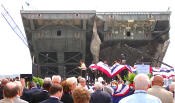 |
Woodrow
Wilson Bridge, the drawspan is lowering in the background behind the ceremony
platform. During the ceremony, the drawspan was raised and lowered two full cycles. It was slow, as it is still under construction with tarpaulins for painting work still attached to the drawspan, and it took about 6 minutes to go from closed to fully open, and about 6 minutes to go from fully open back to closed. When fully operational, the drawspan will take 90 seconds to go from closed to fully open, and 90 seconds to go from fully open back to closed. |
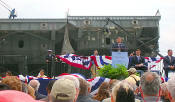 |
Woodrow
Wilson Bridge, the drawspan is lowering in the background behind the ceremony
platform. Speaking at the podium is U.S. Secretary of Transportation Norman Y. Mineta. |
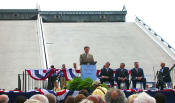 |
Woodrow
Wilson Bridge, the drawspan is rising in the background behind the ceremony
platform. Upon opening the drawspan, the Maryland-side bascule leaves open
first, and then the Virginia-side bascule leaves open. Each 3-lane roadway
has independent bascule leaves. Speaking at the podium is Maryland Governor Robert L. Ehrlich, Jr.. |
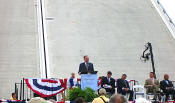 |
Woodrow
Wilson Bridge, the drawspan is rising in the background behind the ceremony
platform. Speaking at the podium is Virginia Governor Timothy M. Kaine. |
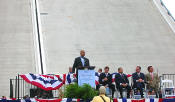 |
Woodrow
Wilson Bridge, the drawspan is rising in the background behind the ceremony
platform. Speaking at the podium is District of Columbia Mayor Anthony A. Williams. |
 |
Woodrow
Wilson Bridge, the drawspan is lowering in the background behind the ceremony
platform. Upon closing the drawspan,
the Virginia-side bascule leaves close first,
and then the Maryland-side bascule leaves close. Standing at the podium is the master of ceremonies Federal Highway Administration Acting Administrator J. Richard Capka. |
 |
Woodrow
Wilson Bridge, the drawspan is lowering in the background behind the ceremony
platform. The local Congressional
delegation present is standing on the platform. |
 |
Woodrow
Wilson Bridge, the drawspan just fully closed in the background.
The local Congressional delegation present is
standing on the platform. |
WWB Ceremony Video is one of the very few forays by Roads to the Future into videotaping, using a 2005 Nikon Coolpix 4100 point-and-shoot camera (which took all the photos on this webpage, which were processed with Adobe PhotoDeluxe Business Edition), and it provides rudimentary videotaping quality. It is a 19-second video of the new and existing bridges, taken at the dedication ceremony, with the theme music playing in the background, with traffic moving on the existing bridge. At 10.3 megabytes, it is large. It looks like clicking it directly will not run the video, but that saving it to your own computer and running it from Windows Explorer as a QuickTimeMovie, will run the video. It can be set to play in a continuous loop so that the music will play in the background as you look at the photos here.
The following 15 photos were taken on May 27, 2006, by Roads to the Future. This is a drive eastbound over the Woodrow Wilson Bridge and approaches, from Virginia to Maryland. The large photos have sizes ranging from 146 to 287 kilobytes, with most of them being under 172 kilobytes.
The following 8 photos were taken on May 29, 2006, by Roads to the Future. This is a drive westbound over the Woodrow Wilson Bridge and approaches, from Maryland to Virginia. The large photos have sizes ranging from 112 to 197 kilobytes, with most of them being under 141 kilobytes.
The following 20 photos show various aerial views of the I-95/I-495 Woodrow Wilson Bridge (WWB) Project construction, including the new Potomac River Bridge construction, the Virginia U.S. Route 1 Interchange construction, the Washington Street Urban Deck construction, and the Maryland Interstate 295 Interchange construction.
These photos were taken on May 31, 2006, by the Virginia Department of Transportation, and are posted here with their permission. Roads to the Future utilized PhotoDeluxe Business Edition to sharpen and brighten and to align all of the photos. Click on the photo to get a large version of the photo. In later versions of Netscape and Internet Explorer, you probably will need to use Full Screen mode (the F11 key can be utilized to swap back and forth between Full Screen and Regular) to see the full size of the large photo without browser-induced image shrinkage. The large photos have sizes ranging from 137 to 267 kilobytes, with most of them being under 176 kilobytes. With a broadband or network Internet connection each photo will download within seconds, but with a dial-up Internet connection it will be somewhat slower.
Lead article - Woodrow Wilson Bridge Project Photos
All photos by Scott Kozel except aerial photos in last group.
This article was released on June 1, 2006, with the 34 photos from May 18, 2006. The 23 photos from May 27 and May 29, 2006, were added on June 8, 2006. The 20 photos from May 31, 2006, were added on August 1, 2006.
Copyright © 2006 by Scott Kozel. All rights reserved. Reproduction, reuse, or distribution without permission is prohibited.
By Scott M. Kozel, Capital Beltway dot com, Roads to the Future
(Created 6-1-2006, updated 8-1-2006, moved to capital-beltway.com on 3-22-2007)


